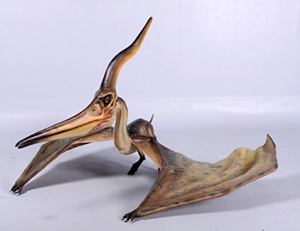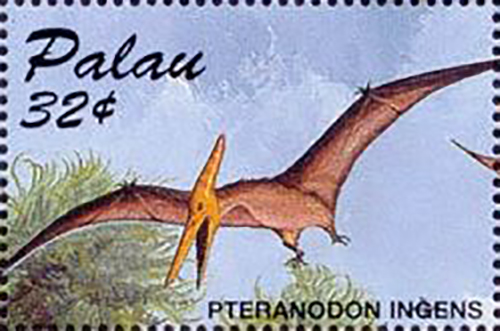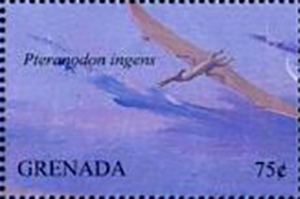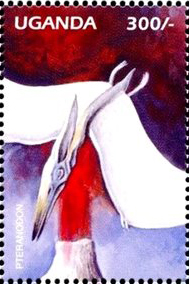Pteranodon ingens Marsh, 1876

Phylum: Chordata Haeckel, 1874
Subphylum: Vertebrata Cuvier, 1812
Classe: Reptilia Laurenti, 1768
Ordine: Pterosauria Kaup, 1834
Famiglia: Pteranodontidae Marsh, 1876
Genere: Pteranodon (Marsh) Williston, 1876
Descrizione
Lo Pteranodon ha un aspetto piuttosto strano. Gli arti posteriori sembrano piuttosto sottili, ma se si confrontano con il torso si vedrà che in realtà sono piuttosto grandi, molto simili a quelli di un uccello o di un altro dinosauro. Le dimensioni e il peso dello Pteranodon sono una specie di illusione ottica. La testa e la cresta sono enormi, ma la testa è cava e pesa molto poco. Il grande becco serve per catturare i pesci e la cresta per esibizione sessuale (quelle delle femmine sono più corte e le loro pelvi sono più larghe). Anche le ossa delle ali sembrano molto grandi, quindi l'animale sembra pesante nella parte anteriore. Ma queste ossa sono anche completamente cave e le pareti sono spesse solo 1 mm. Molte delle ossa hanno dei buchi che mostrano che il tessuto respiratorio dei polmoni si estendeva in queste ossa, come negli uccelli. Questo avrebbe funzionato per raffreddare il sangue dagli sforzi del volo. Queste ossa non hanno bisogno di resistere a forze di compressione (come le zampe), ma devono resistere alle forze di trazione e torsione del volo. La capacità di farlo dipende quasi interamente dal diametro dell'osso, non dallo spessore. Quindi le ossa possono sembrare spesse, ma non pesavano quasi niente. L'intero animale probabilmente non superava i 9-11 kg.
Diffusione
Visse nel periodo Cretaceo nel Kansas, nel Nebraska e di altri stati del Midwest.
Bibliografia
–Bennett, S.C. (2000). "Inferring stratigraphic position of fossil vertebrates from the Niobrara Chalk of western Kansas." Current Research in Earth Sciences: Kansas Geological Survey Bulletin, 244(Part 1): 26 pp.
–S.C. Bennett, The Pterosaurs of the Niobrara Chalk, in The Earth Scientist, vol. 11, n. 1, 1994, pp. 22-25.
–M.P. Witton e M.B. Habib, On the Size and Flight Diversity of Giant Pterosaurs, the Use of Birds as Pterosaur Analogues and Comments on Pterosaur Flightlessness, in PLoS ONE, vol. 5, n. 11, 2010, p. e13982.
–Bennett, S. C. (1987). "New evidence on the tail of the pterosaur Pteranodon (Archosauria: Pterosauria)." Pp. 18–23 in Currie, P. J. e E. H. Koster (eds.), Fourth Symposium on Mesozoic Terrestrial Ecosystems, Short Papers. Occasional Papers of the Tyrrell Museum of Paleontology, #3.
–Kellner, A.W.A., Comments on the Pteranodontidae (Pterosauria, Pterodactyloidea) with the description of two new species (PDF), in Anais da Academia Brasileira de Ciências, vol. 82, n. 4, 2010, pp. 1063-1084.
–Martin-Silverstone, E., Glasier, J., Acorn, J., Mohr, S., and Currie, P. 2017. Reassesment of Dawndraco kanzai Kellner, 2010 and reassignment of the type specimen to Pteranodon sternbergi Harksen, 1966. Vertebrate Anatomy Morphology Palaeontology, 3:47-59.
–Piero e Alberto Angela, Rettili Volanti, in "Il pianeta dei dinosauri", Arnoldo Mondadori Editore, 1993, p. 111.
–Bennett, S.C., Taxonomy and systematics of the Late Cretaceous pterosaur Pteranodon (Pterosauria, Pterodactyloida), in Occasional Papers of the Natural History Museum, University of Kansas, vol. 169, 1994, pp. 1-70.
–Bennett, S.C., Sexual dimorphism of Pteranodon and other pterosaurs, with comments on cranial crests, in Journal of Vertebrate Paleontology, vol. 12, n. 4, 1992, pp. 422-434.
–K Carpenter, Vertebrate Biostratigraphy of the Smoky Hill Chalk (Niobrara Formation) and the Sharon Springs Member (Pierre Shale), in High-Resolution Approaches in Stratigraphic Paleontology, vol. 21, 2003, pp. 421-437.
–Zimmerman, H., Preiss, B., and Sovak, J. (2001). Beyond the Dinosaurs!: sky dragons, sea monsters, mega-mammals, and other prehistoric beasts, Simon and Schuster.
–B. Andres e T. S. Myers, Lone Star Pterosaurs, in Earth and Environmental Science Transactions of the Royal Society of Edinburgh, vol. 103, 2013, p. 1.
–B. Andres, J. Clark e X. Xu, The Earliest Pterodactyloid and the Origin of the Group, in Current Biology, vol. 24, 2014, pp. 1011-6.
–Peter Wellnhofer, The Illustrated Encyclopedia of Pterosaurs, New York, Barnes and Noble Books, 1996 [1991], p. 139.
–Cope, E.D. (1875). "The Vertebrata of the Cretaceous formations of the West." Report, U. S. Geological Survey of the Territories (Hayden), 2: 302 pp., 57 pls.
–Marsh, O.C., Notice of a new sub-order of Pterosauria, in American Journal of Science, Series 3, vol. 11, n. 65, 1876a, pp. 507-509.
–Marsh, O.C., Principal characters of American pterodactyls, in American Journal of Science, Series 3, vol. 12, n. 72, 1876b, pp. 479-480.
–A.O. Averianov, Ornithostoma sedgwicki – valid taxon of azhdarchoid pterosaurs, in Proceedings of the Zoological Institute RAS, vol. 316, n. 1, 2012, pp. 40-49.

|
Data: 22/04/1995
Emissione: Dinosauri Stato: Palau Nota: Emesso in un minifoglio di 18 v. diversi |
|---|

|
Data: 13/04/1994
Emissione: Animali preistorici Stato: Grenada |
|---|

|
Data: 15/07/1995
Emissione: Animali preistorici Stato: Uganda Nota: Serie emessa in foglietto |
|---|

|
Data: 24/03/1998
Emissione: Animali preistorici Stato: Uganda |
|---|